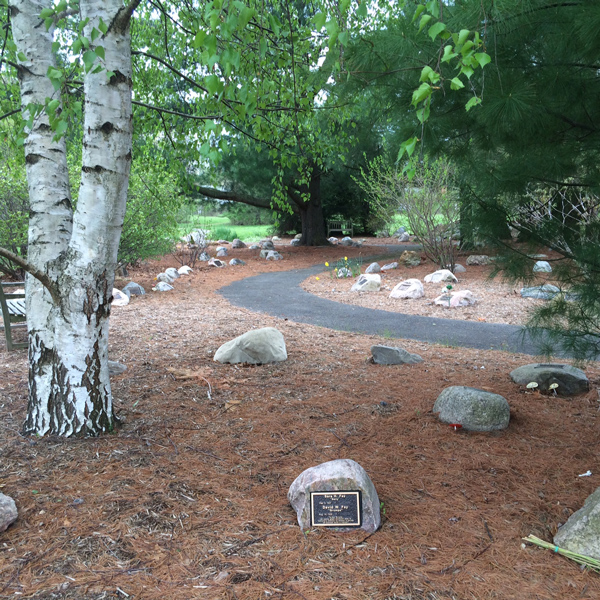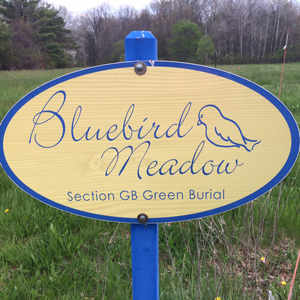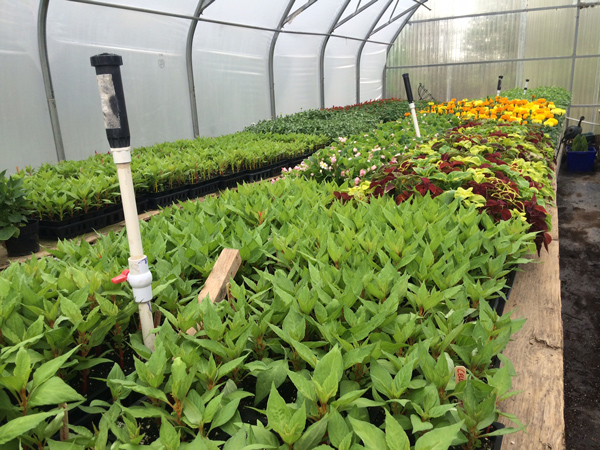
The Park’s Memorial Walk starts out in a gardenesque setting, then makes its way into beautiful woodlands.
Radical Welcome
The 170-acre White Haven Memorial Park in Pittsford is a park for all people. Walkers and runners are welcome,
bicyclists and hikers are welcome, dogs are welcome. Birders can come do their early morning thing, including observing Eastern bluebirds in the Park’s dedicated nesting area. The entrance sign even says “Geocachers
welcome.” One need not have a loved one buried there to enjoy the beautiful natural assets of White Haven— including formidable horticultural assets. There are more than 150 different tree species in the developed areas alone, with dozens more species yet to be inventoried in the Park’s 70-plus acres of forest.
There is a wildflower meadow on the site of the green burial area (“built” wildflower meadows are high-maintenance, as anyone who’s tried one knows!). And the small staff grow more than 15,000 annuals in their own greenhouse each year for the grounds, then work diligently all summer to keep those annuals watered and protected as much
as possible from the Park’s abundant wildlife, who enjoy refuge there.
A huge part of White Haven’s park-like appearance owes to the fact that there are no traditional above-grown tombstones; there are only flat bronze memorials throughout, with the exception of the natural stones and plaques on the Nature Trail that accompany the cremated remains of those who chose that option. The specimen trees and large expanses of lawn with open vistas makes White Haven feel very Olmstedian.
Andrea Vittum has been president of White Haven since 1993, and before that was vice president since 1985. “The first thing you’ll notice when you come here, along with the natural beauty, is that White Haven is called a Memorial Park, not a cemetery,” she says. “Then you’ll notice the fact that you won’t see the word ‘No’ on any of our signage.”
That wasn’t always the case. Back in 1995, Vittum organized a Vision Day for the staff, where employees at every level came together to brainstorm the mission for White Haven. There was a unanimous feeling that the Park should be profoundly more welcoming to the public. “It was a huge turning point for us,” Vittum says. “We all felt that this place was for the living as well as for the dead, and that we wanted people to have the opportunity to come here and develop happy memories…We knew that this transformation would make White Haven more of a comforting and healing place, valuable to everyone, as we all eventually have to contend with loss and grief.”
With that mission in mind, the Park put in new, welcoming signage, renovated the whole front of the main building to make it more welcoming and accessible, and began to pursue a wider range of uses and designations that would further engage the public. For instance, in 1993, White Haven became the first cemetery in the country to participate in the Audubon Cooperative Sanctuary program sponsored by Audubon International, and in 1998, they were the first cemetery to become fully accredited in all five areas of participation, which include setting up bird sanctuaries and implementation of Integrated Pest Management to greatly reduce pesticide use.
Tree Recognition
The most recent feather in the Park’s cap is Level 1 Arboretum Certification by the Arbnet Arboretum Accreditation Program, which puts the Park on the Morton Arboretum Register of Arboreta. Information on each species and the location of specimen trees is available in the Park’s office and White Haven is working towards having an online tree walk available to anyone with a smartphone. Having conducted a tree inventory that gathered that information was one of the requirements for Level 1 Arboretum Accreditation.
The Park’s tree inventory actually began back in 1989 as a project of interest to Vittum. “I was working on getting a tree map of the whole park because even then we had close to 100 species,” she says. She was going to do a booklet about 50 of the most magnificent trees and she hired a photographer who came several times a year to photograph each tree at its showiest season. “We had this incredible catalog of photos, but then in 1991 we had a horrific ice storm in which many of the specimen trees were badly disfigured. I lost my heart for the project at the time because so many of the trees no longer looked like they did in the photos— it was very sad.”
Fast-forward to several years ago, when Vittum was reading in a national cemetery magazine about a new phenomenon of cemeteries becoming arboreta. Enough time had passed such that the wounds (to tree and heart) of the ice storm had healed. She passed her 1991 data along to Assistant Vice President Nate Romagnola and Director of Horticulture Gary Burke, who set about creating a current inventory and database of the trees in the developed areas.
“Our database has been a helpful tool when someone comes in and wants to know what the tree near their loved one is,” Romagnola says. Part of the inventory process was affixing numbered labels to the trees, which both gives a reference point to help people find their loved ones in the Park and helps Park staff more readily locate burial sites.
Vittum, Romagnola, and Burke have big plans to further their outreach. “We want to bump up to Level 2 certification by having more educational opportunities and by refining the database and increasing its utility,” Romagnola says. “We would love, for example, to have college tree ID or arboriculture classes, Master Gardeners, and other groups use the Park for educational purposes.” Romagnola thinks that more cemeteries would pursue Arbnet Arboretum Accreditation if they knew about it. When there’s already a strong tree resource in place, “it can be just a matter of getting the paperwork done,” he says.
Making it All Grow
As head grower, Interment and Garden Foreman Adam Romagnola (Nate’s brother) oversees the production of almost 15,000 annuals in the Park’s greenhouse. “It’s a lot of fun, and it saves the organization money over buying in all those plants,” he says. At seed-buying time, Romagnola and Burke are looking for those plants with the biggest color impact, because the bold display beds are equal in importance to the tree collection in making the grounds appealing in summer. “We choose things that are colorful and straightforward to grow, like zinnias, marigolds, celosia, salvias, geraniums, dahlias, and cannas,” Romagnola says.
“The only annuals we buy in are begonias and ‘Victoria Blue’ salvia,” Burke says. He explains that ‘Victoria Blue’ proved too fussy a germinator, and begonias have to be started in greenhouses in January. The horticulture department decided it was more economical to wait until February to fire up the greenhouse, so they buy the begonias in.
Adam Romagnola says, “We tweak things every year to become better growers and to find things that are going to work in the big display beds.” For instance, one year the crew planted ‘Benary’s Giant’ zinnias rather densely, and ended up with a powdery mildew problem. They learned to use cosmos instead, which has feathery foliage and allows for better air circulation.
One year the red salvia was hit with aphids. “We learned that we needed to mix something else in with that red salvia so that if or when it died out, we’d still have something red there,” Romagnola says. “Now we interplant it with red celosia, which fills in the space if necessary.”
As to perennials? Burke says, “There are some perennial beds that we maintain, but they are high maintenance for the amount of more muted color they offer, so we prefer annual beds with splashy colors.” Burke says they’d love to grow even more annuals for display, but the greenhouse space is maxed out, and includes growing extras for replacements for deer and other mishaps. “The deer run the show when the sun goes down here,” Adam Romagnola says. “Yet we enjoy the wildlife that live here, as do the visitors. You get to see the same big bucks coming back year after year, and sometimes new ones.”
The team uses regular applications of Liquid Fence to protect the annuals. “I’ve sprayed it so much, the smell doesn’t even bother me anymore,” Romagnola says. They also try to pick plants that deer won’t favor. He says that while the deer won’t eat the geranium flowers, they will eat the geranium buds. “Even when you put the Liquid Fence on,” Burke says, “the deer will sometimes pull the plants up and spit them out—it can be discouraging.” The deer will also sometimes munch on or strew about fresh cut flowers that families put on gravesites. Newly planted trees get trunk protection via corrugated plastic tubes, to protect the tender cambium from rutting bucks.
What’s really amazing is that all of the horticulture/grounds crew are also doing interments, so when you ask them how many full-time equivalents they have on horticulture staff, it’s very hard to say, because the burial schedule is unpredictable. “We have the freezing days when you’re jackhammering the soil for burial, but other times you’re in the greenhouse or planting flowers—we enjoy the variety of the things we do,” Burke says.
More About Horticulture at White Haven
- The larger display beds have automatic irrigation; the smaller ones are watered by hand from a 150-gallon tank. “We like to put the knowledgeable seasonal employees on watering because they know how important it is,” Romagnola says.
- There are five mature ash trees in the developed collection that are being micro-injected to project the trees from Emerald Ash Borer.
- The oldest and largest tree is a red oak (Quercus rubra) in the center of the developed Park. Gary Burke is partial to a large shagbark hickory (Carya ovata) and Andrea loves the large Nootka cypress (Cupressus nootkatensis). Other interesting specimens include Kentucky coffeetree (Gymnocladus dioicus), Katsura tree (Cercidiphyllum japonicum), Japanese snowbell (Styrax japonicus), tupelo (Nyssa sylvatica), yellowwood (Cladrastis kentukea), American fringetree (Chionanthus virginicus), goldenchain tree (Laburnum anagyroides), paperbark maple (Acer griseum), and six different kinds of beech trees.
- The soil on the property ranges from very sandy in the front portion to clayey and wet in the back acreage. The property was previously an airfield, and before that, a farm.
- The staff maintains a giant compost pile in the back, using leaves and funeral flowers as its primary components.
- The wildflower meadow is a struggle to perpetuate, but one very cool thing is that each family who buries a loved one in the green burial meadow receives wildflower seeds and is invited to sow them, resulting in lovely spots of color come August. The staff also plants plugs every year. Adam Romagnola says, “We spend a lot of time on it, but I’m hopeful the wildflower meadow will eventually be self-sustaining.”
Michelle Sutton (michellejudysutton.com) is a horticulturist, writer, and editor.
Views: 5








